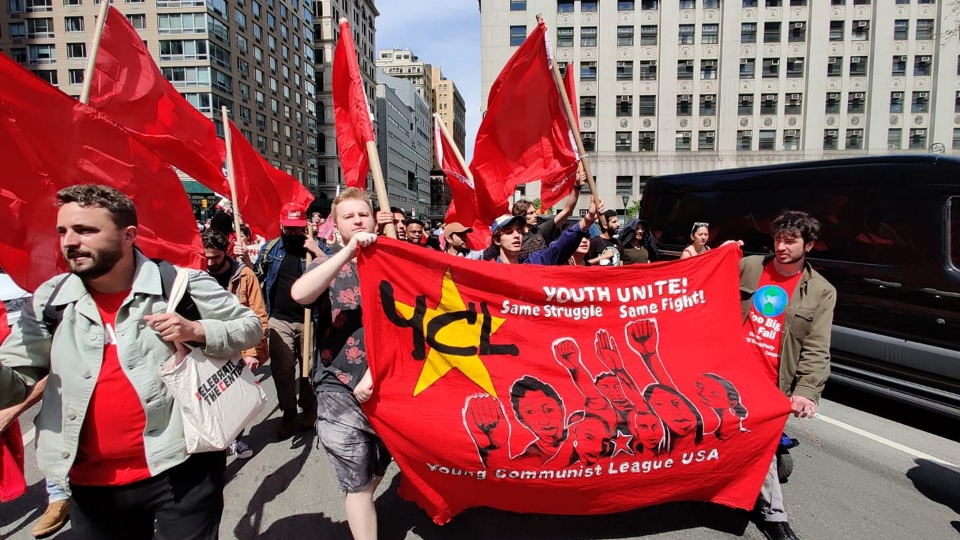
NEW YORK—On International Workers Day, hundreds of people and dozens of unions and radical organizations hit the streets of Manhattan to support workers in the fight against capitalist exploitation. This year’s May Day action was the largest in New York in a decade. Members of many organizations marched, carrying red flags and signs in solidarity with the labor movement. As it always has, May Day continues to celebrate the resilience of militant workers’ struggles and to fight for the interests of the working class.
Just as it took a coalition of groups to help the Amazon Labor Union win its decisive victory, this year’s May Day represented the unity of working-class groups in fighting toward winning workers’ power. Organizations present included Teamsters Local 79, the ALU, New Immigrant Community Empowerment (NICE), RWDSU, the Communist Party USA, Make the Road New York, Churches United for Fair Housing (CUFFH), Building Trades for Worker Democracy, Industrial Workers of the World (IWW), Arab American Association of New York, and many more.
ALU’S historic victory set the stage for this resurgence of militant labor activity in New York. One UPS driver and Teamsters Local 804 member named Matt spoke of the impact recent rank-and-file struggles have had for the labor movement:
“There’s been a broad trend of worker organizing and empowerment. Last year, it was the Kellogg and John Deer strikes, people were talking about this wave. Now, the first union at Amazon in the history of the country is happening, and we’re looking toward next summer when our contract is going to expire. This is gonna be the first time in two decades or more we’ve had a new leadership that’s been militant, looking toward the next contract. Now people are getting excited, and knowing that there’s stuff happening elsewhere is part of the momentum that we need to have our own fight and potential strike in 2023—which would be the biggest private employer strike in the history of the country. These things are coming together; the left is building its political power, and this day is a picture of that.”
May Day not only represents the fight of workers within specific industries but the importance of combating racism and all forms of worker subjugation. Organizations at the Manhattan march made clear their solidarity with immigrant workers in the struggle against capitalist exploitation because under this economic system it is their labor that is especially exploited for super-profits. From the agricultural sector to Amazon, Black and brown immigrant workers have to face the brunt of a system that values profits people.
As a representative from the Arab-American Association of New York pointed out, these workers are not only the most vulnerable under the capitalist system, but it is their labor that makes production in these industries possible, to begin with:
“We are now three years into the pandemic, and we still witness the devaluing of workers, especially immigrant workers. This country was founded on the labor of immigrant workers. From farm workers to factory workers, this country was founded on exploitation. This country survives on the labor of immigrants in every industry. We are here in the streets to demand more for immigrant workers, we demand healthcare, shelter, and a pathway to citizenship. We want more for the workers that this country exploits every single day and uses for cheap labor.”
Simultaneously, the May Day event showcased the achievements of workers in the fight for better conditions in the essential labor they provide. One worker, Jason Anthony, a lead organizer in the Amazon Labor Union, alluded to this point, stating:

“We should not only recognize the struggles of the workers’ movement, but also we should acknowledge their achievements. We should be acknowledging and receiving immigrants that come from all over. New York City is a melting pot, that is why it is so diverse and that is why there’s so many types of workers. This is why it’s so important to recognize workers because we move everything, not the billionaires, not the one percent, but the 99% moves the economy.”
Reviving the legacy of radical organizations in the labor movement was another feature of the march. Communists and other radical groups continue to struggle for less exploitative working conditions while also fighting to transform the system of production that oppresses in the first place.
As the German revolutionary Rosa Luxemburg emphasized, even after the eight-hour workday was achieved, there would continue to be a collective fight against capitalism until workers won possession of the full potential of their labor. She wrote: “The first of May demanded the introduction of the eight-hour day. But even after this goal was reached, May Day was not given up. As long as the struggle of the workers against the bourgeoisie and the ruling class continues, as long as all demands are not met, May Day will be the yearly expression of these demands.”
Prassana, a co-chair of the Young Communist League, emphasized that throughout the struggle of the ALU, it was individuals from varying allied groups and organizations that made it possible for the ALU to win. As Prassana emphasized, the Communist Party continues to be an essential part of the workers’ struggle toward liberation: “ALU was a popular front, it had people from all ideologies, backgrounds, nationalities, races, all represented. That includes the Communist Party, we were there, we’re gonna be there, we’re going to be doing what we can to help support the workers and build up the labor movement of this country again.”
May Day reminds us of the potential and power of the working class. As C. E. Ruthenberg, the first leader of the Communist Party USA, once wrote: “May Day—the day which inspires fear in the hearts of the capitalists and hope in the workers—the workers the world over—will find the Communist movement this year stronger in the U. S. than at any time in its history…The road is clear for greater achievements, and in the United States as elsewhere in the world the future belongs to Communism.”
In an issue of the Weekly Worker, Eugene V. Debs wrote in a May Day edition published on April 27, 1907: “This is the first and only International Labor Day. It belongs to the working class and is dedicated to the revolution.”
This is an abridged version of an article that earlier appeared at CPUSA.org.










